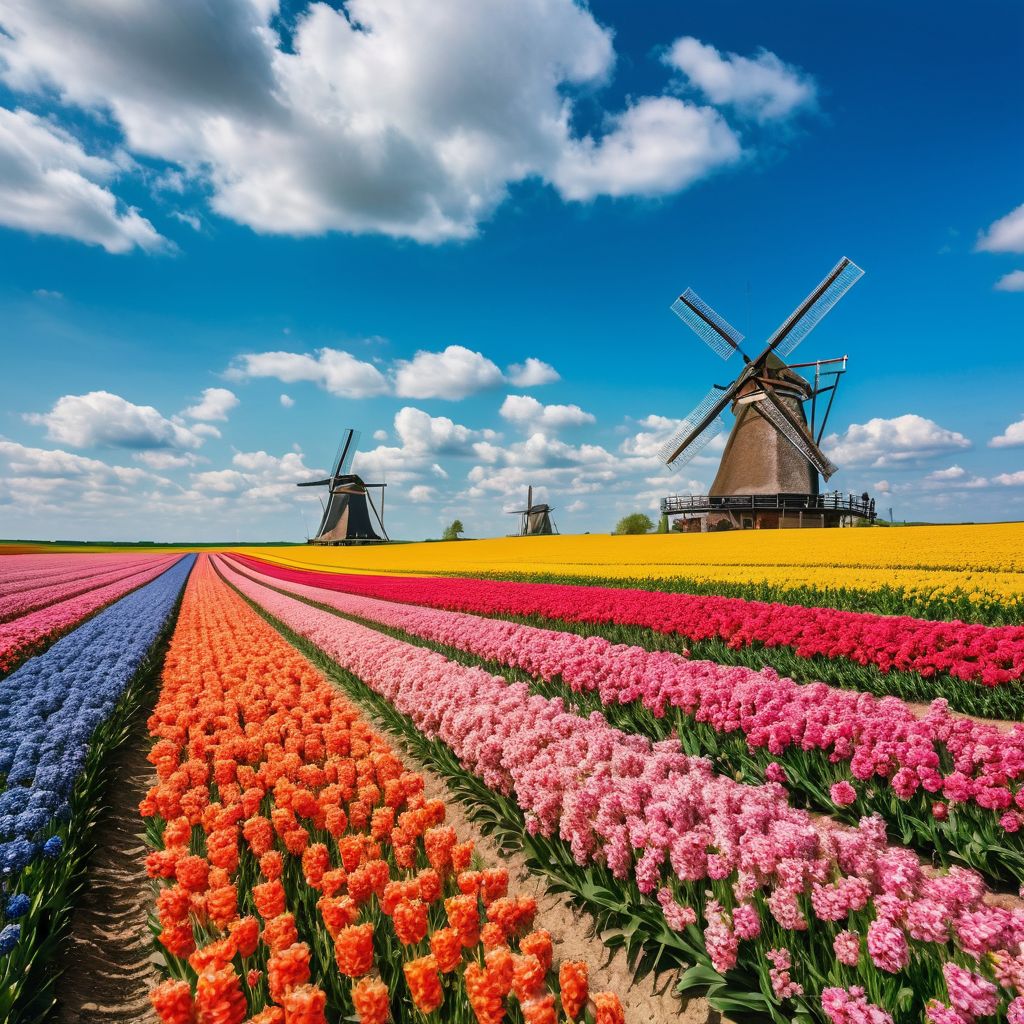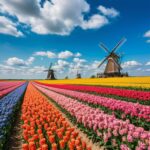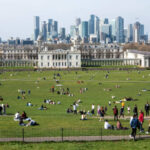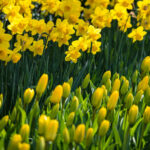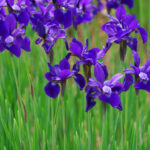Keukenhof Gardens: The Jewel of Dutch Floriculture
Introduction
Nestled in the town of Lisse, Netherlands, Keukenhof Gardens, also known as the “Garden of Europe,” is one of the world’s largest and most spectacular flower gardens. Covering nearly 79 acres and hosting over seven million flower bulbs, Keukenhof is a vivid tapestry of color and a celebration of Dutch horticulture. Every spring, the garden comes alive with an astounding array of flowers, especially tulips, symbolizing the rich botanical heritage of the Netherlands. Visitors from across the globe flock to Keukenhof to witness this breathtaking display, making it a premier destination for flower lovers and an iconic attraction in Dutch tourism.
Historical Background
Keukenhof Gardens has a fascinating history that dates back to the 15th century. The land that now forms the garden originally belonged to Countess Jacoba van Beieren (1401–1436), who used it as a hunting ground and a source of herbs for her kitchen. This culinary connection led to the name “Keukenhof,” which translates to “kitchen garden” in Dutch. In the 19th century, the landscape architects Jan David Zocher and his son, Louis Paul Zocher, designed the park around the Keukenhof Castle, inspired by English landscape gardening styles.
The garden took on its present form in 1949 when a group of prominent Dutch flower bulb growers and exporters conceived the idea of a permanent exhibition of spring-flowering bulbs. Their vision was to create a showcase for the Dutch floriculture industry and promote flower bulbs on an international scale. Since its official opening in 1950, Keukenhof Gardens has transformed into a global phenomenon, welcoming millions of visitors each season and serving as a living exhibition of the Dutch passion for gardening and flowers.
The Layout and Design of Keukenhof Gardens
Keukenhof Gardens spans a vast area divided into themed gardens, pavilions, and natural landscapes, each offering unique experiences. The primary elements of its design include winding paths, gently flowing streams, ponds, fountains, and statues, creating a harmonious fusion of art and nature. Every season, the layout of the gardens is meticulously planned to provide a fresh experience, incorporating different flower varieties, color schemes, and arrangements to delight returning visitors. While the overall aesthetic remains consistent, the gardens offer something new each year, as horticultural experts devise creative, intricate patterns and layouts.
The gardens are divided into themed sections, each highlighting various aspects of Dutch floriculture:
- The Historical Garden: A tribute to the roots of Dutch horticulture, this section showcases old bulb varieties and traditional Dutch flower-growing techniques. Visitors here gain insight into the historical evolution of the Dutch flower industry.
- The Nature Garden: This section emphasizes a more natural landscape, incorporating native plants, wildflowers, and a tranquil pond surrounded by dense foliage. It offers a peaceful contrast to the more structured floral displays and celebrates biodiversity.
- The Modern Garden: Known for its striking, avant-garde floral designs, the Modern Garden introduces contemporary elements and experimental arrangements, attracting visitors interested in innovative garden design.
- The Japanese Garden: Styled with Japanese aesthetics in mind, this area features serene paths lined with cherry blossoms and other Asian-inspired plants. It reflects the universal appeal of flowers and symbolizes cultural exchange.
- Pavilions: Keukenhof’s several pavilions are dedicated to specific flowers, with names like Oranje Nassau, Willem-Alexander, and Beatrix honoring members of the Dutch royal family. Each pavilion showcases different flower types in vibrant, artistic displays, from orchids to lilies.
The gardens also feature a scenic windmill that provides a classic Dutch touch, offering visitors a perfect photo opportunity and a panoramic view of the surrounding tulip fields.
The Flowers of Keukenhof
The flowers are, of course, the stars of Keukenhof Gardens. Every spring, more than seven million bulbs bloom across the park, transforming it into a vibrant sea of color and fragrance. While tulips are the primary attraction, Keukenhof also features a stunning array of hyacinths, daffodils, lilies, roses, carnations, irises, and more. These flowers are planted in a precise sequence to ensure a continuous display of colors and shapes throughout the garden’s eight-week season.
Tulips: The Pride of Keukenhof
Tulips are synonymous with the Netherlands, and Keukenhof is the ultimate showcase of this iconic flower. The gardens display tulips in a remarkable range of colors, patterns, and varieties, including single and double blooms, fringed petals, parrot tulips, and more. Visitors will see nearly every conceivable shade, from classic reds and yellows to rare purples, blacks, and variegated varieties.
The tulip’s story is intertwined with Dutch history and culture, dating back to the 16th century when the flower was introduced to the Netherlands from the Ottoman Empire. Tulip mania in the 17th century led to an economic bubble, making the flower both a symbol of prosperity and a cultural fascination. Today, the tulip remains a national symbol, and Keukenhof Gardens serves as its premier stage.
Other Flowering Bulbs and Varieties
While tulips are the primary attraction, Keukenhof also hosts an impressive array of other spring-flowering bulbs. Hyacinths add a rich fragrance to the air, with their dense clusters of tiny flowers creating a carpet of pink, blue, and white hues. Daffodils bring cheer with their bright yellow and white petals, signifying the arrival of spring, while anemones, crocuses, and bluebells add further depth and diversity to the floral display.
The gardens are also known for their lilies, particularly showcased in the Willem-Alexander Pavilion. With over 100 types of lilies on display, this pavilion is one of the largest lily exhibitions in the world and attracts visitors seeking to admire the flower’s beauty and sophistication.
The Visitor Experience
A trip to Keukenhof Gardens is a sensory journey that immerses visitors in beauty, fragrance, and color. The gardens offer a well-curated visitor experience with paved paths that guide guests through different sections and scenic viewpoints that invite them to pause and absorb the atmosphere. The park’s layout ensures easy navigation, and the landscape design encourages exploration, making every visit feel like a new discovery.
Keukenhof is especially popular with photographers and nature enthusiasts, as the vibrant colors and serene landscapes provide countless opportunities for capturing memorable images. The gardens are wheelchair accessible, and various amenities like cafes, souvenir shops, and picnic areas are thoughtfully placed around the park to accommodate the needs of all visitors.
In addition to the gardens themselves, Keukenhof offers a range of activities and attractions. Boat tours take visitors through the surrounding flower fields, offering an alternative perspective of the tulip landscape, while bike rentals allow them to explore the picturesque Dutch countryside at their own pace.
For families, Keukenhof has activities designed to engage children, including a petting zoo, playgrounds, and scavenger hunts. These features make it an ideal destination for people of all ages, ensuring everyone can enjoy the gardens’ wonders.
Annual Themes and Events
Each year, Keukenhof Gardens chooses a different theme, which serves as inspiration for the floral displays and various events. Past themes have celebrated the history of the tulip, Dutch art and culture, and international partnerships. The annual theme is reflected in the design of flower beds, pavilions, and artistic installations around the park, adding a layer of meaning and storytelling to the visual display.
Keukenhof also hosts a range of events during its eight-week season, including:
- Flower Shows: Each pavilion hosts flower shows dedicated to specific types of flowers, such as lilies, orchids, roses, and daffodils. These exhibitions are carefully curated by floral experts and showcase the latest trends and innovations in floral design.
- Flower Arranging Demonstrations: Visitors can attend live demonstrations where professional florists create stunning arrangements, providing inspiration and insight into the art of floristry.
- Cultural Performances: On weekends and special occasions, Keukenhof hosts music and dance performances that celebrate Dutch culture and enhance the festive atmosphere of the garden.
Keukenhof’s Environmental and Economic Impact
Keukenhof Gardens plays a vital role in promoting environmental awareness and sustainability. The park employs eco-friendly practices, including water recycling systems, sustainable planting techniques, and integrated pest management to minimize environmental impact. Keukenhof’s emphasis on biodiversity and sustainable practices also inspires visitors to adopt eco-friendly practices in their gardens.
Economically, Keukenhof is a significant contributor to Dutch tourism and the floriculture industry. It attracts more than a million visitors each year, boosting the local economy and generating employment opportunities. The garden’s global recognition has positioned the Netherlands as a leader in horticulture, encouraging partnerships and collaborations within the industry.
The Cultural Significance of Keukenhof Gardens
Keukenhof Gardens is more than just a tourist attraction; it embodies the Dutch cultural identity and heritage. The garden is a symbol of the Dutch people’s love for nature, innovation, and craftsmanship. It is a place where tradition meets modernity, showcasing centuries-old gardening techniques alongside contemporary horticultural practices.
The tulip, as a national symbol, also holds deep cultural significance. It represents resilience, beauty, and the cycle of life. Keukenhof’s emphasis on the tulip reflects the pride the Dutch have in their historical connection to the flower, from the heights of Tulip Mania to the present-day celebration of floriculture.
Conclusion
Keukenhof Gardens is a marvel of horticultural artistry and cultural pride, offering an unparalleled experience that captures the essence of Dutch floriculture. From its rich history as a “kitchen garden” to its modern role as the world’s premier flower garden, Keukenhof stands as a testament to the beauty and diversity of the natural world. Its carefully crafted landscapes, vibrant floral displays, and commitment to sustainability make it a unique desti
Whether you are a flower enthusiast, a nature lover, or a curious traveler, a visit to Keukenhof Gardens is an unforgettable experience that celebrates the beauty of spring and the enduring charm of the Netherlands. As the world’s garden, Keukenhof invites us all to appreciate the wonders of nature and the artistry of floriculture, ma



